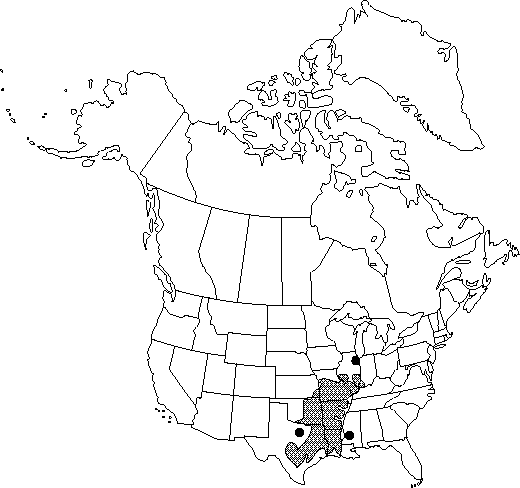Carya texana
Proc. Acad. Nat. Sci. Philadelphia 12: 444. 1860.
Trees, to 41 m. Bark dark gray to black, ridged and deeply furrowed. Twigs rusty brown, slender, densely scaly, often pubescent. Terminal buds rusty brown, ovoid, 4-9 mm, densely scaly; bud-scales imbricate; axillary buds protected by bracteoles fused into hood. Leaves 2-5 dm; petiole 3-8 cm, glabrous or with scattered coarse hairs, or rarely pubescent, usually with dense coating of scales imparting rusty brown color. Leaflets (5-) 7 (-9), lateral petiolules 0-1 mm, terminal petiolules 2-10 mm; blades ovate to obovate, elliptic, or linear-elliptic, not falcate, 3-15 × 1-8 cm, margins finely to coarsely serrate, apex acuminate; surfaces abaxially hirsute along base of midrib, otherwise without hairs or hirsute with unicellular and 2-8-rayed fasciculate hairs, densely covered in spring with a few silvery tan, large, peltate scales and many small, 4-lobed, irregular, and round peltate scales imparting rusty brown color, adaxially without hairs, moderately scaly, becoming glabrous. Staminate catkins pedunculate, to 16 cm, stalks with dense coating of rusty brown scales, bracts scaly, with hairs at apex; anthers hirsute. Fruits bronze to reddish-brown, obovoid to spheric, not compressed, 3-5 × 2.5-3.5 cm; husks 2-4 mm thick, dehiscing to base or nearly so, sutures narrowly winged; nuts tan, obovoid, slightly compressed, usually not angled, occasionally 2-4-angled, rugulose; shells thick. Seeds sweet. 2n = 64.
Phenology: Flowering spring.
Habitat: Well-drained sandy soils on rolling hills and rocky hillsides, occasionally on low flat lands and marl soils
Elevation: 0-500 m
Distribution

Ark., Ill., Ind., Kans., La., Miss., Mo., Okla., Tex.
Discussion
Carya texana occurs principally west of the Mississippi River. It hybridizes with C. glabra, C. tomentosa (C. ×collina Laughlin), seemingly intergrades with C. pallida in eastern Missouri and southern Illinois, and is reported to hybridize with the diploid C. aquatica [C. ×ludoviciana (Ashe) Little].
Selected References
None.